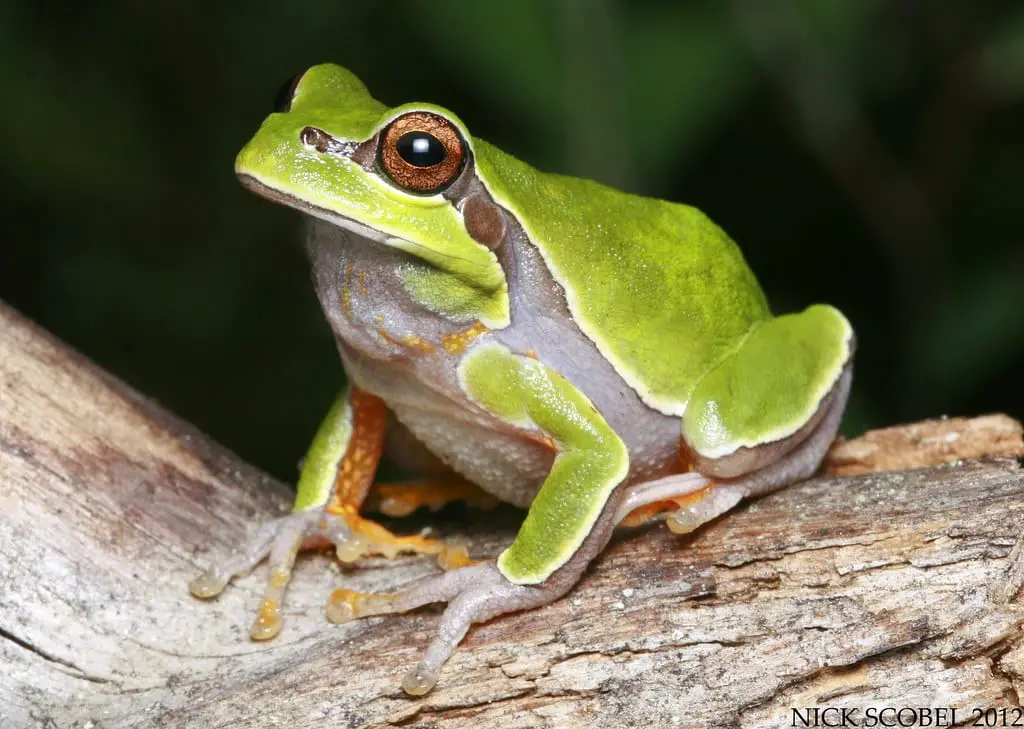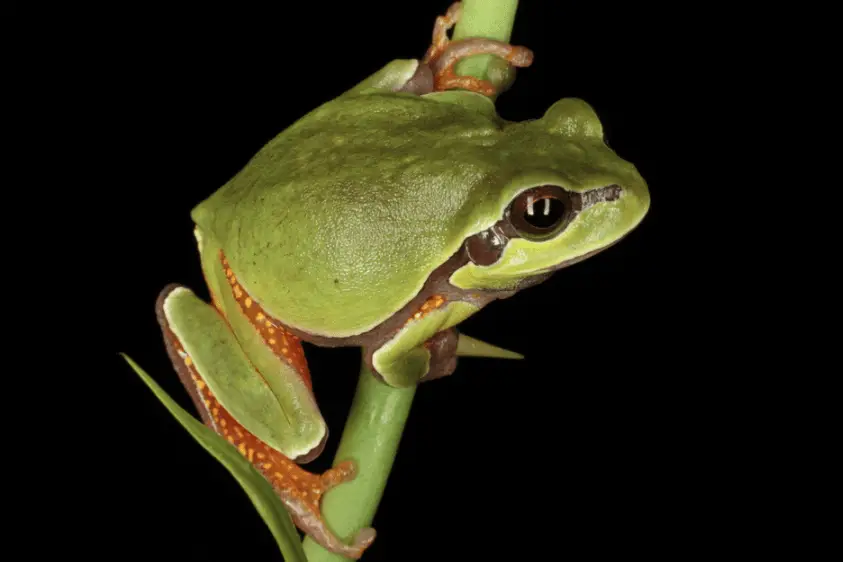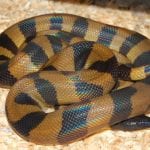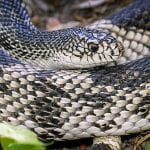Scientific Facts
| Common Name: | Pine Barrens Treefrog |
| Scientific Name: | Hyla andersonii |
| Life Span: | 2 to 5 years |
| Care Level: | Intermediate |
| Size: | 1 ¼ to 1 ¾ inches |
| Habitat: | Sandhills, Pine Barrens, peat bogs, and hillside seeps |
| Country of Origin: | The United States of America, particularly, Alabama, New Jersey, North Carolina, and South Carolina |
Physical Description

Pine Barren Treefrog is famous for its vibrant green skin and bold marks. It is a beautiful amphibian species that are marked by a purple stripe bordered with yellow and white. This stripe extends from its snout through its eye, then to the sides of their body. The undersides or bellies are white in color, and you will be able to spot a bright orange patch below each of its hind legs. Because of this, you will be able to witness a flash of color whenever it leaps. On its throat, you will be able to see a purple color that is even more pronounced in the males of the species.
Conservation Status
According to the IUCN’s Red List, the Pine Barrens Treefrog is a species that is Near Threatened based on their global assessment dated April 30, 2004. The threats against the species have been traced due to the following things:
Agriculture and aquaculture
- Annual timber crops
- Perennial timber crops
Natural system modifications
- Establishment of dams
- Water management
Pollution
- Domestic waste
- Urban waste
- Water pollution
Transportation
- Habitat changing into roads and railroads
Residential and commercial development
- Commercial establishments
- Industrial establishments
- Housing
- Urban developments
Life Span
The Pine Barren treefrogs live 2 to 5 years, but it can even be longer if they are well taken care of.
Availability and Natural Habitat
Pine Barren treefrogs from South Carolina to Southern New Jersey. On some occasions, they have been seen as far south as West Alabama and as far as South Florida. They reside in pools during a certain part of the year. When they dry up during the summer months, they live on the damp soil in dark shaded areas of raspberry bushes. The tadpoles swim in ponds or pools, adults are terrestrial, and they live near water.
Behavior
Pine Barren treefrogs are familiar with the sounds that they make. It is similar to a “quonk quonk quonk” sound which is fired rapidly and also produced quite nasally. Scientists have observed that these sounds are produced faster during warmer temperatures, and they were slower during cooler weather.
These frogs are nocturnal, which means they are more active during the night. They enjoy climbing and playing around vegetation and vines.
Diet
Pine Barren treefrogs eat small invertebrates, including ants, beetles, crickets, flies, spiders, and other similar insects. While they are still young tadpoles, they feed on algae, very small invertebrates, and aquatic vegetation.
Eating Habits
Adult Pine Barrens treefrogs are predatory. When they are still in the earlier stages, the tadpoles eat algae and vegetation in the water. Adult tree frogs eat beetles, butterflies, flies, small slugs, snails, and moths. They use their tongues to catch the organisms and eat them.
Development and Reproduction
During the early days of May, when temperatures are warming up, and rainfall is also increased, the mating season of the Pine Barren tree frogs begin. This moment stimulates the increased calling of the males of the species. Usually, they will be heard vocalizing from the ground or from vegetation beside a breeding pond. The schedule of these mating calls begins a few minutes before sunsets and peak during the humid evenings, especially when June comes.
When the mating season commences, the Pine Barren tree frogs hide within the ground or perch in trees to rest during the day. Then, they emerge to begin foraging through the night. All the breeding sessions occur during the night time.
After a female frog bears child, they will lay their eggs in the breeding pond one at a time, to minimize the risk of losing their young. When they have finished laying eggs, their clutch can be a total of 1,000 eggs. These eggs, which are fertilized by the male Pine Barren tree frogs, can even be attached to sphagnum moss, or it can rest on the bottom of the pond. After a week or two, these eggs hatch as tadpoles.
Depending on rainfall, weather conditions, or other external factors, these tadpoles will begin their transformation into tailed froglets within 3 months, more or less. The tails of these froglets will have fat reserves that will give the frogs sustenance until they learn how to hunt for their prey.
As they mature, the young frogs will begin living in wet meadows, bogs, or forests where they will remain for the duration of the season.
Common Health Problems
When taking care of an animal, you always expect that they might encounter illnesses one way or another. Some red flags that you should watch out for are bloated abdomens, weak leg movements, weight loss, distressed breathing, loss of appetite, skin lesions, and lethargy.
On the other hand, a sign of a healthy Pine Barren treefrog is active, alert, clear eyes, healthy skin, and eats regularly with a maintained weight.
Here are the common health issues of Pine Barren treefrog:
1) Chemical intoxication
This can be caused by exposure to detergents, soap, pesticides, ointments, and other similar chemicals. To solve this, protect your pet frog from exposure and consult with an exotic pet veterinarian.
2) Intestinal obstruction
This can be caused by eating too many hard-shelled insects or by accidentally swallowing gravel or other substrates. For your pet’s recovery, surgery to clear the obstruction might be required.
3) Nutritional deficiencies
Illnesses like this are seen through lethargy, weak hind legs, and changing skin colors. To prevent this, make sure that you provide a balanced diet to your pet. Use vitamin and mineral supplements and consult your trusted veterinarian if the symptoms persist.
4) Skin problems
This can be caused by accidental abrasions, bacteria, and fungal infections. A topical medicine or antibiotics will be prescribed by an amphibian specialist doctor to resolve this health concern.
Handling
For pine barren tree frogs, do not handle them unless it is necessary. If there ever comes a need to handle your frog, always wear latex gloves. The oil on your skin or any form of the residue of other items can harm your pet frogs. Also, for your sake, amphibians secrete toxins, and those secretions contacting your eyes, mouth, or open wounds can come with dangers.
Caging
The cage of a Pine Barren treefrog must appropriately size and shaped home to give way to normal behavior and exercise. The best cage would be a glass enclosure with a tight-fitting screen lid. Glass enclosures are preferred because it is a great medium to ensure that the heat passes through while ensuring that the cage is cool enough.
In terms of sizing, they should be at least 30 cm in length and 50 cm in height. This space would be large enough to move around in, and the height will allow them ample areas to climb.
The habitat that you design for your pet frog must have an abundance of plants. You can use driftwood or other types of branches. You also have the option to use non-edible plants and artificial plants or cover the enclosure’s back wall with dark green material. You can also use large suction cups to attach slabs of cork back to the back wall for a realistic effect.
Substrate
For cage substrates, you can use mulch-type ones like bark, coconut fiber, dampened sphagnum moss. You must avoid the usage of artificial turf and gravel, as this can be too harsh for the skin of your pet Pine Barren tree frog.
Pine Barren tree frogs would adapt better in places with a slightly moist substrate, which is better in retaining the humidity inside the terrarium. Looser substrates can also be eaten and swallowed by the tree frogs.
Lighting
For a Pine Barren treefrog, the ideal lighting for the enclosure should at least last for about 10 to 12 hours a day is a must. You should use fluorescent lighting for this one. For their basking area, you should provide an incandescent day bulb during the daylight hours. You must also install a low-level UVB light for the skin needs of your pet. Also, provide them with hiding places throughout their enclosure so that they can hide from the light when needed.
In the type of enclosure that the Pine Barren tree frog has, the lights are generally held in a canopy above the mesh ceiling. UVB lighting is required so that your frogs have the freedom to absorb Vitamin D3 inside their skin.
Temperature
The ideal temperatures of a Pine Barren treefrog enclosure must be around 80 degrees Fahrenheit to 88 degrees Fahrenheit during the day. The ideal temperature at night must be cooler, at about 68 degrees Fahrenheit.
To achieve this, you can stick a large heat mat on one side of the enclosure. Just to be safe, use a thermostat to regulate the temperature.
Humidity
The ideal humidity levels for a Pine Barren treefrog is around 70 to 90 percent. For achieving proper humidity levels, misting in the cage must be done every day, or you can opt for installing a fogger machine in the enclosure.
Cleaning
As water is required in the housing of the pine barren tree frogs, cleaning their habitat must be done at least once a week. Place the frog in a secure habitat, scrub the entire tank, scrub the furnishings in the enclosure, rinse everything thoroughly with hot water, then dry everything completely. Finally, add the new substrate for the cage.
Fun Facts about the Pine Barren Treefrog
- Pine Barren Treefrogs belong to the family Hylidae and the genus Hyla.
- One reason for the habitat loss of these frogs is the difference in water quality and an increase in pH levels.
- The Pine Barren treefrog prefers living in areas that are carpeted with thick moss.
- Pine Barren treefrogs are terrestrial, but they enjoy living near areas with water sources.
- The female Pine Barren treefrogs often lay their eggs in ponds with acidic pH levels.
- The Hyla andersonii, or the Pine Barren treefrog, is declared to be the state frog of North Carolina.
- The Pine Barren tree frogs can be identified by their quonk-quonk sound.
Where Can You Get a Pet Pine Barren Treefrog?
The Pine Barrens Treefrogs are viewed as endangered in their local natural habitats. If you want to have one and make them your pet, you need to apply for special permits to be allowed access to one.
How to Care for a Pet Pine Barren Treefrog?
To take care of Pine Barren tree frogs, you should give them fresh, clean, chlorine-free water. Make sure that this is available at all times and is replaced daily. For a healthier pet, try a feeding rotation that will broaden their diets. You must also include supplements in their meals, especially vitamin D3 ones.
Frequently Asked Questions
What do Pine Barren Treefrogs eat?
Pine Barren treefrogs eat invertebrates that are smaller sized than them. Their young feeds on algae and other aquatic vegetations.
How does a Pine Barren treefrog sound?
Pine Barren treefrogs sound like “quonk quonk quonk.”
Why is the Pine Barren treefrog declared as the official state frog of North Carolina?
The Pine Barren treefrog was chosen by the state to represent the unique animal diversity of North Carolina, and the Pine Barren treefrog won after 6,000 total votes.
Why are the Pine Barren treefrogs called their names?
These amphibians got their name because they are found only in the Pine Barren forests of the states along the eastern side of the United States.
Why are Pine Barren treefrogs multi-colored?
The coloration of these amphibians allows them to be camouflaged amid vegetation.



